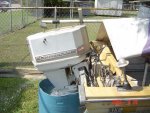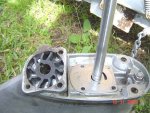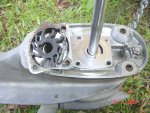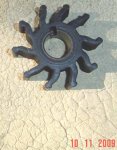Re: i need help how to set points on force 50
Frank's reply below in another thread to the above post might help you as it will help me. Bottom Line! Some skills and time will be needed to get basic fixes and the best performance. Good Luck! JOW
First, before we get into marks, it is necessary to understand that setting point gaps must be done ACCURATELY on each set, as small--extremely small differences between them cause bigger differences in timing between the two cylinders and loss of performance. So: Some Chrysler engines had two marks on the flywheel 180 degrees apart for TDC of each cylinder. That way you could test the timing on each cylinder to be certain they were both the same.
Some cams have a mark on them, some don't. Some have an arrow indicating direction and when installing the cam, the arrow must be up. The mark makes it easy to be certain both point sets are set at the same height on the cam-- If you only had one set of points, you would not need a reference line.
I never read the 10 degrees past in Clymers and I always set my points to .020 at the high spot on the cam or the mark if it has one. Most of these cams I have seen have a long dwell time so the high spot is a segment, not a point, and easy to find. Quite Frankly--no pun intended-- I don't set them much any more and this is the kind of thing I analyse when I get the flywheel off, then decide where to set the points. If I get it wrong, no biggie: I just pull the flywheel and do it again like I say below.
BTW: I have spoken to some old time Chrysler mechanics who insist the two cylinder engines run better with the points at .016 but I have never tried it. I can tell you that my alternator 50 started and ran with less than a .005 gap. Started and ran way better when I re-set them to .020
At any rate, you are not going to ruin the engine if the points are a little off and if you don't hit it the first time simply pull the flywheel and try again.


















